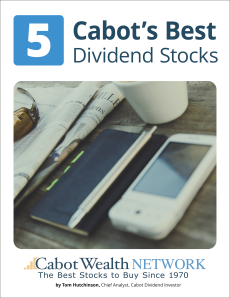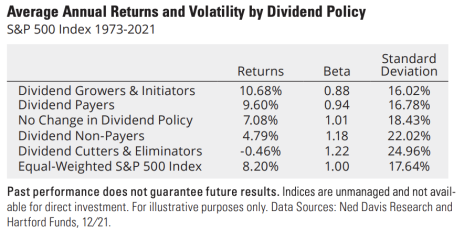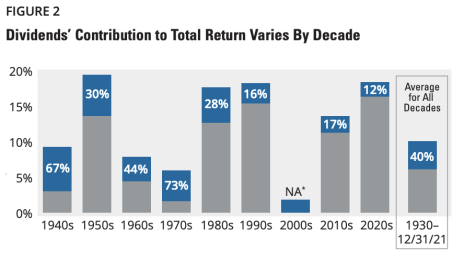by Tom Hutchinson, Chief Analyst, Cabot Dividend Investor and Cabot Income Advisor
Dividend stocks are the place to be. Whether you want to build your wealth or get an income or anything in between, you need to know the dividend story.
Dividend stocks have been one of the most successful wealth building investments in history. Few people know this. In fact, a lot of people I know regard them as boring. They want to find the next Amazon or Microsoft. Some of them will. Some people will win the lottery too. It happens, just not to you.
If you’re serious about making money in the market and want investments that actually have a high-percentage chance of working, dividend stocks are your answer. In fact, you’ll be amazed at how realistic it is to grow your wealth and fund your retirement without losing your shirt in the attempt. Below I highlight five of the absolute best dividend investments on the market.
But first, let’s go over some facts about dividend stocks.
The Track Record
From 1973 through 2021, dividend-paying stocks provided an average annual return of better than 9% compared to just over 2% for non-dividend payers, more than four times the return. Believe me, that makes an enormous difference over time.
And it’s not just outperformance. Dividend stocks have achieved such superior returns with less risk and volatility. That’s a big deal, because downside and volatility are the things that scare us out of the market and prevent us from participating in the market’s historical upward trend.
Dividends have always been a huge part of stock market investing. In fact, between 1930 and 2021, dividends represented 40% of overall market returns. Prices go up and down and sideways, while dividends keep rolling in no matter what.
S&P 500 Total Return: Price and Dividend Contribution
But that’s just the money. Another big part of the reason these stocks have been so successful is because the companies that pay them and grow them are just plain better. Dividends are actually a great indicator of the very best companies to own.
[text_ad]
Strong dividend payers are predominantly large and mature businesses with proven market niches and competitive advantages. Such characteristics enable them to generate consistent and predictable revenue streams from which they are able to make regular payouts. As the chart below displays, dividend payers as a whole tend to be far more profitable businesses than non-dividend payers.
Not All Dividends are the Same
Sure, dividend-paying stocks have outperformed the overall market and blown away the return of non-dividend payers. But not all dividend stocks are good investments. This cherished group has its share of dogs too.
Choosing a stock starts with a thorough analysis of the individual company, its industry and the outside environment. But, aside from the typical numbers crunching when considering any stock (i.e. earning prospects, balance sheet, management, etc.) there are some general considerations to make when specifically analyzing a company’s dividend.
- Payout ratio
The payout ratio represents the percentage of earnings that are paid out in dividends, calculated as earnings per share divided by dividends per share. This number represents how extended the company is paying the current dividend and can reflect if the current dividend is on thin ice or if there is room for growth.
However, payout ratios are relative. Certain industries, such as utilities and telecommunications, tend to pay out a higher percentage of earnings in dividends while other industries typically pay out a lower percentage. A payout ratio should be measured against the industry average, its historic average and whether it has been rising or falling.
It seems simple—but it’s also crucial. A company needs to consistently earn plenty of money from which to pay the dividend. Some companies try to fake you out. But income and cash flow statements tell the tale. This needs to be checked because the market is cruel to companies that cut the dividend.
- Earnings growth
Earnings fuel the dividend and the stock price. It’s essential that a company exhibits a consistent track record of growing earnings. But even more importantly, there needs to be a strong reason to believe the company can continue to grow earnings in the future.
A company needs to have a strong niche in a business that can grow. Ideally, a business should be well positioned ahead of a powerful and undeniable trend such as catering to an aging population or selling to the growing emerging-market middle class.
- Dividend growth
Just like dividend-paying stocks are a subset of the overall market that have outperformed, stocks with growing dividends are a subset of dividend stocks that have consistently outperformed that group. Between 1973 and 2021 Dividend Growers and Initiators in the S&P 500 returned more than Dividend Payers by more than 1% per year, on average.
Companies that have grown their dividend consistently reflects not only consistent earnings growth but management’s commitment to the dividend. Also, growing dividends is a great defense against inflation. Unlike bonds, dividend stocks can increase payments during times of rising prices.
The Wealth-Building Power of Dividends
There is an income crisis in America. It used to be that a person who retired at 65 didn’t expect to live much longer. Not anymore. Now, people are living another 20 or 30 years after they retire. That’s fantastic. But it also creates a problem. How do you not run out of money?
You need an income generated by your money that you can live on without blowing through the principal. Few people have pensions anymore and Social Security is designed to be just a supplement. After taxes and inflation there’s nothing left.
Dividend stocks are the only answer out there. Yes, CDs and Treasuries have high yields at the moment thanks to the Fed having its foot on the gas on interest rates, but we’re still talking 4.5-5% yields, max. With dividend stocks, you can get a respectable income and hopefully grow your principal in a much shorter span. The demand for these investments should be high and that will help boost prices over time.
But let’s say you don’t need the income now. Dividends are fantastic wealth builders. Reinvesting dividends has a compounding effect on an investment, delivering jaw-dropping returns over time. Reinvested dividends buy more shares of stock. More shares of stock pay still more dividends. And if the dividends grow and the stock price appreciates, the returns can be astounding.
Suppose you buy 1,000 shares of a $20 stock, a $20,000 investment. Also assume that the stock pays a 5% yield ($1 per year) when you buy it and over the next 10 years the dividend grows by an average of 5% per year. Let’s also assume that the stock price appreciates an average of 5% per year over the next 10 years.
If you just reinvest the dividends without adding another dime of your own money to the investment, that $20,000 investment will grow to over $53,000 in 10 years. And that’s with modest and realistic criteria. It would be like buying a home 10 years ago for $200,000 that’s now worth $530,000. Wouldn’t you think you made a brilliant investment?
Okay, enough of the theoretical stuff; let’s take a look at some real-life examples. Here’s how a $20,000 investment made 10 years ago (11/28/2013 to 11/28/2023) would have grown with dividends reinvested in some well-known blue-chip stocks.
Altria (MO): $40,321.67
PepsiCo (PEP): $53,384.05
McDonald’s (MCD): $75,450.76
Visa (V): $107,865.68
Caterpillar (CAT): $77,362.82
Mind you, these aren’t up-and-comers in nanotechnology or artificial intelligence. They are household names you can own without worrying.
That’s great. But you probably don’t have a functioning time machine that would enable you to go back 10 years and make these investments. Anybody can go back and look at what already happened. The trick is to find great investments for the next 10 years.
Okay, fair enough. I’ll take the Pepsi challenge. Here are five dividend stocks that have a good chance to earn great returns over the next 10 years.
Cabot’s Five Best Dividend Stocks
ONEOK, Inc. (OKE)
Annual yield: 5.7%
5-year dividend growth rate: 8.7%
ONEOK, Inc. (OKE) (pronounced ONE-OAK) is a leading midstream service provider and owner of one of the nation’s premier natural gas liquids (NGL) systems, connecting NGL supply in the Rocky Mountain, Mid-Continent and Permian regions with an extensive network of natural gas gathering, processing, storage and transportation assets.
Originally founded in 1906 as an intrastate natural gas pipeline business in Oklahoma, today ONEOK is one of the nation’s premier energy companies involved in the natural gas and natural gas liquids businesses. It is a Fortune 500 company and is included in the S&P 500.
ONEOK’s revenues increased 35% in 2022, while earnings per share was up more than 14%. All that growth has helped keep the stock afloat during a turbulent time for the market - OKE shares are up about 14% since the start of 2022, versus a 4% drawdown in the S&P 500.
Even though OKE is a long way below the pre-pandemic high (77), there is great yield and great value here. You can collect the huge yield and very likely get some nice appreciation well into 2024 - and beyond.
This is a great energy stock that’s still cheap in a great environment for all things natural gas.
Brookfield Infrastructure Partners (BIP)
Annual yield: 5.8%
5-year dividend growth rate: 4.7%
The world is in an infrastructure crisis.
Infrastructure is defined as the basic facilities, services, and installations needed for the functioning of a community or society. The term typically refers to technical structures such as roads, bridges, water supply, sewers, electrical grids, telecommunications and so forth.
Systems in the developing world have aged and decades of unprecedented growth have left emerging markets with an urgent need to provide basic infrastructure to support growing urban populations.
Multiple studies have shown the world to be operating at an infrastructure deficit of anywhere between $30 trillion and $70 trillion over the next 20 years. The World Economic Forum’s Positive Infrastructure Report finds that the world faces a global infrastructure deficit of $2 trillion per year over the next 20 years.
Brookfield Infrastructure Partners is a global infrastructure Master Limited Partnership (MLP) based in Bermuda that owns infrastructure assets all over the world. The company is a rare gem that offers both defensive earnings and strong growth. Infrastructure is just coming into vogue for investors as the issue is becoming well known. Even President Biden has made it an issue.
Brookfield owns and operates infrastructure assets all over the world. The company particularly focuses on high-quality, long-life properties that generate stable cash flows, have low maintenance expenses and are virtual monopolies with high barriers to entry.
Its assets include toll roads in South America, ports in Europe, railroads in Australia and natural gas midstream assets in North America. Brookfield was early to the party and was able to hand-pick some of the very best assets. The results speak for themselves. The stock has returned an average of more than 12% per year over the last 10 years.
But the future could be even better! Analysts expect earnings over the next five years to be significantly higher than the last five. As a Master Limited Partnership, BIP pays out most of its profits in the form of distribution, and yields more (currently 5.8%) than most regular dividend payers.
AbbVie (ABBV)
Annual yield: 4.5%
5-year dividend growth rate: 17.7%
Markets go up and down—always have, always will. There will be recessions and recoveries and bull markets and bear markets. But certain trends will continue through it all. One such trend is the unmistakable and inevitable aging of the population.
Because of longer life spans and diminishing fertility rates, the population in the U.S. and around the globe is older now than ever before. In the U.S., nearly a third of the population is 50 or older. An average of 10,000 baby boomers will turn 65 every single day, and the fastest-growing segment of the population is 65 and older.
That makes healthcare a growth industry as well as a defensive one, meaning it thrives in any economy. Profits roll in no matter what. And what do you know—healthcare has been one of the best-performing market sectors in the latest bull market and one of the more resilient sectors over the past tumultuous year and a half.
The company I like best right now is one that combines the stability and high dividend payout of a big pharmaceutical company with the high growth rate of a biotechnology company. The stock has posted an average annual return of 19.5% since it was spun off from Abbott Laboratories (ABT) in early 2013.
Most of its current valuation metrics are below that of the five-year average and the stock yields a solid 4.5%. This combination of high yield and growth is AbbVie Inc. (ABBV).
AbbVie is a cutting-edge, research-based pharmaceutical company specializing in small molecule drugs. It uses biology on living things to effect the next generation of medicine in addressing the world’s health needs.
Its cash cow is Humira, the world’s top-selling drug for autoimmune diseases. However, the drug still accounts for most of AbbVie’s revenue and faces increasing competition. But the company’s pipeline is strong enough to more than offset the slippage in Humira sales.
According to market research firm EvaluatePharma, AbbVie has the second-most valuable clinical pipeline across all of biopharma. There are no guarantees, but AbbVie has enough to throw at the wall that the odds of overall success are high relative to most other companies.
Broadcom Inc. (AVGO)
Annual Yield: 1.9%
3-year dividend growth rate: 42.7%
Broadcom, Inc. (AVGO) is a technology industry Goliath with more than $35 billion in annual net revenues. It’s an icon of the technology revolution with roots that trace back over 50 years to the old AT&T/Bell Labs. The company has many category-leading products in crucial areas of semiconductors and infrastructure software solutions.
The company essentially provides crucial equipment that enables technology to function as we know it today. It provides components that enable networks to operate together and communicate with each other from the service provider all the way the end user and device.
All that may sound complicated. But there are two simple reasons for buying the stock. One, it is benefiting from the current environment as more businesses move online and into cloud-based applications. Two, it will get a huge benefit from the 5G rollout in both the short and longer term.
Analysts are expecting revenue growth of 9.3% and earnings growth of 11.4% for 2023. That’s decent growth for a stock that sells at 18 times forward earnings as of this writing. The company is also approaching a huge technological expansion from 5G in the years ahead. Keep in mind that an investment in this stock produced a total return better than 2,000% over the last 10 years.
Then there’s the dividend.
It’s a huge benefit to have a growth technology company that also pays a dividend. At the current price, AVGO pays a 1.9% yield. But the growth potential of the dividend is the main event.
Over the past five years, AVGO grew the payout by a staggering compound annual growth rate (CAGR) of 42%. The yield-on-cost of an initial investment in the stock five years ago would now be 10.8%.
Demand for products in cellular connectivity, networking and data centers is sharply on the rise and should continue to grow for some time. Broadcom is one of the best in the business at providing the products that enable such things. More and more devices will need to connect to the internet and interact with each other as new 5G technology launches technological innovation and the digital economy to another level.
The timing seems great for AVGO, especially after the company announced a new multi-billion-dollar deal with Apple, which already accounts for 20% of its revenue. It’s a great way for more conservative investors to play in the technology sandbox while getting a growing dividend.
Chevron (CVX)
Annual yield: 4.2%
5-year dividend growth rate: 4.8%
Chevron is one of the world’s largest integrated oil and gas companies, with operations throughout the world. The company is involved in virtually every facet of the energy industry including oil and gas exploration and production, refining and marketing, power generation and piping and storage.
The company is a Dow Jones Industrial Average component and ranks 23rd on the Fortune Global 500 list of the top 500 corporations worldwide. While a company this size is involved in every step of the energy cycle, about 80% of earnings are generated from the upstream segment, meaning exploration and production of oil and gas.
This country is undergoing an oil boom, and Chevron will benefit. Chevron has a huge and growing presence in the Permian Basin, the largest shale oil producing region in the United States. Located in Western Texas and part of New Mexico, the area alone is currently cranking out 3.2 mb/d, almost a third of all U.S. production. But it’s just getting started.
It is the fastest-growing oil region in the world. According to global information provider IHS Markit, output from the Permian Basin was expected to double between 2017 and 2023. At that point this region as a nation-state would be the third-largest oil producer in the world, behind only Russia (for what it’s worth these days) and Saudi Arabia.
Technology is a beautiful thing and it is improving rapidly in the energy sector, partially because of pressure and demand for low-cost extraction necessitated during the oil price crash. It’s lowering production costs, which is key given where oil costs are now in the midst of the Russia/Ukraine conflict.
Chevron’s share price is down 18% year to date, so it’s ripe for the picking now. Momentum in both the energy sector and in CVX’s share price has returned as oil prices hover in the $75 to $90 range.
How to Learn More
Cabot Dividend Investor has three related objectives: safety, dividend growth and current income. Subscribers are guided in how to mix and match our recommendations to meet whichever of these objectives is most important to you personally. Some subscribers choose to pursue only one or two objectives while some mix investments to secure all three.
Cabot Dividend Investor is for anyone who wants to receive income from his or her investment portfolio, now or in the future. If you need income now, you’ll focus on our current income recommendations from the Safe Income and High-Yield Tiers of the portfolio.
If you don’t need income now but anticipate needing it in the future (or just want to put the power of dividend growth to work for you), you’ll focus on our Dividend Growth Tier, and may choose to reinvest your dividends—which you now know how to do!
Regardless of whether or not you decide to subscribe to my advisory, I hope this report has been informative and educational, and you’ve learned a little more about dividend stocks—and how they can enhance your portfolio and create wealth that can last for years!
About the Expert
Tom Hutchinson is Chief Analyst of Cabot Dividend Investor and a Wall Street veteran with extensive experience in multiple areas within the financial world. His experience includes specialized work in mortgage banking, commodity trading and as a financial advisor to the nation’s largest investment banks.
Tom has created and actively managed investment portfolios for private investors, corporate clients, pension plans and 401Ks. He has a long track record of successfully building wealth as well as providing a high income while maintaining and growing principal. Tom has written extensively on various industries, individual companies and most every kind of investment for Motley Fool, StreetAuthority, NewsMax, and several of the nation’s largest online publications.
A Proven, Trusted Source
The Cabot Wealth Network was founded in 1970 by Carlton Lutts, a disciplined investor with an engineering mind who developed a proprietary stock picking system using technical and fundamental analyses.
Carlton personally researched and wrote the hugely influential Cabot Market Letter which recommended many big-time profitable trades.
Since then Cabot Wealth Network has grown to become one of the largest and most-trusted independent investment advisory publishers in the country, serving hundreds of thousands of investors across North America and around the world.





